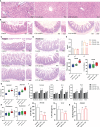Polysaccharide from aerial part of Chuanminshen violaceum alleviates oxidative stress and inflammatory response in aging mice through modulating intestinal microbiota
- PMID: 37153605
- PMCID: PMC10162438
- DOI: 10.3389/fimmu.2023.1159291
Polysaccharide from aerial part of Chuanminshen violaceum alleviates oxidative stress and inflammatory response in aging mice through modulating intestinal microbiota
Abstract
Aging is a biological process of progressive deterioration of physiological functions, which poses a serious threat to individual health and a heavy burden on public health systems. As population aging continues, research into anti-aging drugs that prolong life and improve health is of particular importance. In this study, the polysaccharide from stems and leaves of Chuanminshen violaceum was obtained with water extraction and alcohol precipitation, and then separated and purified with DEAE anion exchange chromatography and gel filtration to obtain CVP-AP-I. We gavaged natural aging mice with CVP-AP-I and performed serum biochemical analysis, histological staining, quantitative real-time PCR (qRT-PCR) and ELISA kit assays to analyze inflammation and oxidative stress-related gene and protein expression in tissues, and 16SrRNA to analyze intestinal flora. We found that CVP-AP-I significantly improved oxidative stress and inflammatory responses of the intestine and liver, restored the intestinal immune barrier, and balanced the dysbiosis of intestinal flora. In addition, we revealed the potential mechanism behind CVP-AP-I to improve intestinal and liver function by regulating intestinal flora balance and repairing the intestinal immune barrier to regulate the intestinal-liver axis. Our results indicated that C. violaceum polysaccharides possessed favorable antioxidant, anti-inflammatory and potentially anti-aging effects in vivo.
Keywords: Chuanminshen violaceum; antiinflammatory; antioxidation; gut microbiota; gut-liver axis; polysaccharide.
Copyright © 2023 Zou, JiZe, Li, Zhang, Fu, Yin, Li, Song, Li, Zhao, Feng, Huang, Ye, Tang, Li, Chen, Chen and Tian.
Conflict of interest statement
The authors declare that the research was conducted in the absence of any commercial or financial relationships that could be construed as a potential conflict of interest.
Figures









Similar articles
-
Extraction, characterization and intestinal anti-inflammatory and anti-oxidative activities of polysaccharide from stems and leaves of Chuanminshen violaceum M. L. Sheh & R. H. Shan.J Ethnopharmacol. 2024 Oct 5;332:118357. doi: 10.1016/j.jep.2024.118357. Epub 2024 May 17. J Ethnopharmacol. 2024. PMID: 38763374
-
A Pectic Polysaccharide from Codonopsis pilosula Alleviates Inflammatory Response and Oxidative Stress of Aging Mice via Modulating Intestinal Microbiota-Related Gut-Liver Axis.Antioxidants (Basel). 2023 Sep 19;12(9):1781. doi: 10.3390/antiox12091781. Antioxidants (Basel). 2023. PMID: 37760084 Free PMC article.
-
Apple polysaccharide improves age-matched cognitive impairment and intestinal aging through microbiota-gut-brain axis.Sci Rep. 2024 Jul 13;14(1):16215. doi: 10.1038/s41598-024-67132-4. Sci Rep. 2024. PMID: 39003416 Free PMC article.
-
The modulatory effect of plant polysaccharides on gut flora and the implication for neurodegenerative diseases from the perspective of the microbiota-gut-brain axis.Int J Biol Macromol. 2020 Dec 1;164:1484-1492. doi: 10.1016/j.ijbiomac.2020.07.208. Epub 2020 Jul 29. Int J Biol Macromol. 2020. PMID: 32735929 Review.
-
Polysaccharides play an anti-fibrotic role by regulating intestinal flora: A review of research progress.Int J Biol Macromol. 2024 Jun;271(Pt 2):131982. doi: 10.1016/j.ijbiomac.2024.131982. Epub 2024 May 8. Int J Biol Macromol. 2024. PMID: 38724335 Review.
Cited by
-
The rejuvenating influence of young plasma on aged intestine.J Cell Mol Med. 2023 Sep;27(18):2804-2816. doi: 10.1111/jcmm.17926. Epub 2023 Aug 23. J Cell Mol Med. 2023. PMID: 37610839 Free PMC article.
-
Trends in intestinal aging: From underlying mechanisms to therapeutic strategies.Acta Pharm Sin B. 2025 Jul;15(7):3372-3403. doi: 10.1016/j.apsb.2025.05.011. Epub 2025 May 22. Acta Pharm Sin B. 2025. PMID: 40698139 Free PMC article. Review.
-
Supplementing probiotics during intermittent fasting proves more effective in restoring ileum and colon tissues in aged rats.J Cell Mol Med. 2024 Mar;28(6):e18203. doi: 10.1111/jcmm.18203. J Cell Mol Med. 2024. PMID: 38445809 Free PMC article.
-
Antioxidant Activity of Radix Cyathula officinalis Kuan Polysaccharides and Their Modulatory Effects on the Gut Microbiota of Caenorhabditis elegans.Curr Issues Mol Biol. 2025 Jul 11;47(7):538. doi: 10.3390/cimb47070538. Curr Issues Mol Biol. 2025. PMID: 40729007 Free PMC article.
-
Gut Microbiome Interactions with Oxidative Stress: Mechanisms and Consequences for Health.Pathophysiology. 2024 Jun 21;31(3):309-330. doi: 10.3390/pathophysiology31030023. Pathophysiology. 2024. PMID: 39051221 Free PMC article. Review.
References
MeSH terms
Substances
LinkOut - more resources
Full Text Sources
Research Materials

